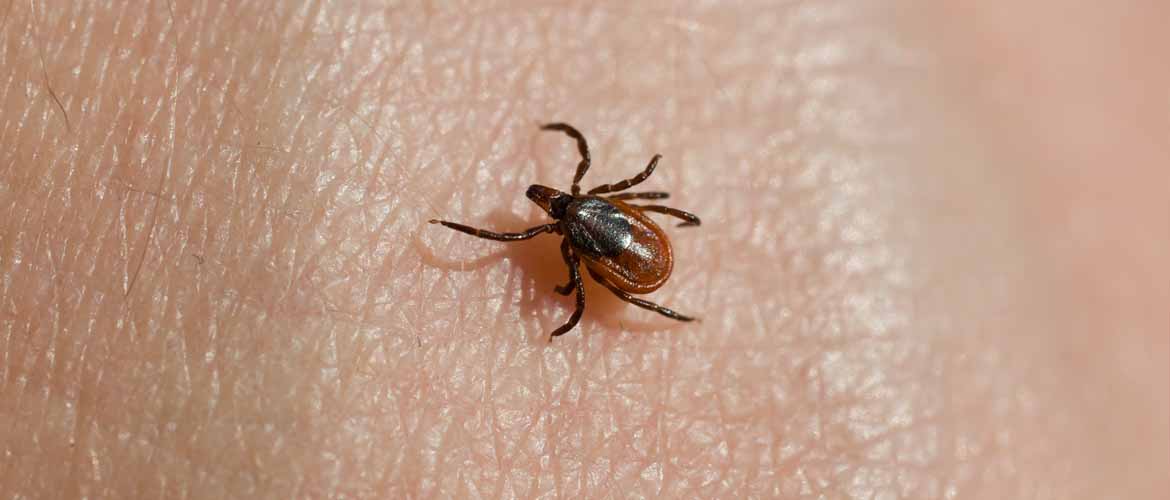August 29, 2024
Between the rising temperatures and a growing population of white-footed mice, scientists are predicting a rise in ticks. While most animals can carry ticks, white-footed mice host a bacteria that causes Lyme disease. When a tick feeds on mouse blood, the tick acquires Lyme disease and can then pass it along to other animals or humans.
Whether your summer is being filled with gardening, hiking, or just enjoying the great outdoors, brush up on these 5 tips to prevent tick bites and Lyme disease.
Spray It

Before you head outdoors, be mindful to spray all of your clothing and outer garments with a repellant that contains 0.5% permethrin.1 Because ticks are so tiny, they often will crawl up and under your clothing. To get the most protection possible, it’s important to turn your pants and shorts inside out and spray that surface first and then spray the entire outside surface. And when it comes to your family’s shoes, spray the outside and inside, too.
To find the repellant that is right for you and your family, check out this online tool from The Environmental Protection Agency.
Turn Up the Heat

After you’ve been outside in a wooded area, the first thing you should do is remove all of the clothing you’re wearing and put it in the dryer. Ticks are vulnerable to drying out, and the best way to completely kill them is to dry your clothes on high for at least 10 minutes. If you have an electric dryer, add an extra 5 minutes as electric dryers aren’t as hot as gas dryers. Not sure if your dryer is gas or electric? This handy guide will help.
MedExpress Pro Tip: Never throw clothes into the hamper or into hot water without first drying them on high heat. Ticks aren’t killed from hot water and leaving them in the hamper puts the next person to touch them at risk.
Wash It Off

Once you’ve removed all of your exposed clothing, be sure to promptly shower and perform a “tick check.” Using a hand-held or full length mirror, review all parts of your body, especially these spots:
- Underarms.
- In and around ears.
- Backs of the knees and between your legs.
- Around your waist and groin areas.
- In and around your head and hair.
Ticks inherently know to crawl upward until they find thinner areas of skin to bite, such as the groin, behind the knees, the neck, and head. Because children frequently lay, roll, and play on the ground, they have a higher risk of encountering a tick.
Bag It and Tag It

Even with proper precaution, there is still a chance you can catch an unexpected hitchhiker. If you happen to spot a tick on you or your child, it’s important to remove the tick quickly and correctly. Keep pointy tweezers and a Ziplock bag handy at all times. It’s important to save the tick in case you ever need to submit it to a lab to be examined for possible risk of infection. Be sure to record the location and date of the bite.
MedExpress Pro Tip: It’s best to remove the tick with pointy tweezers, which can help grab it right next to your skin. You don’t want to squeeze the body of the tick, which will push all the germs in its stomach to its mouth, which is attached to your skin.
Spruce Up the Landscaping

Don’t let the fear of Lyme disease keep you indoors all summer. You can modify your landscaping and yard space to be less appealing to ticks by creating “tick-free zones.” You’ll want to keep patios, decks, and children’s play areas away from any shrubs or vegetation and in the sun, if possible. Be mindful to regularly mow the lawn and remove leaves and brush from around your home and the edges of your lawn. If your lawn is bordered by wooded areas, aim to place a three foot wide barrier of gravel or wood chips between your lawn and the wooded area. This will help to prevent tick migration into your lawn.
If you were bitten by a tick and have symptoms of Lyme disease, be sure to record all your symptoms and visit your local MedExpress. Our full medical team is ready and waiting to treat you, so you can get back to enjoying summer. Read on for more information on Lyme disease.
Originally published June 2017. Updated August 2024.
share this post on Facebook
References:
1 CDC. Preventing Tick Bites. Last updated June 11, 2024. Accessed August 29, 2024.
